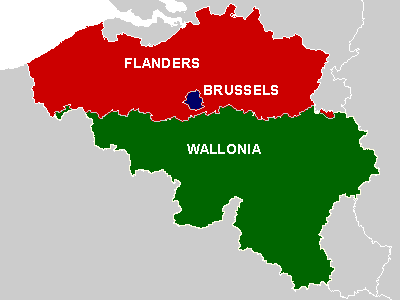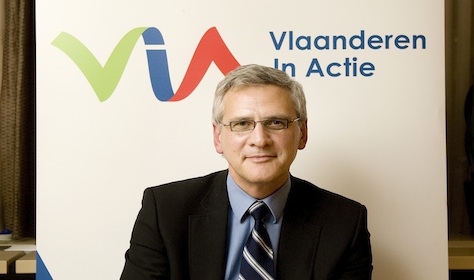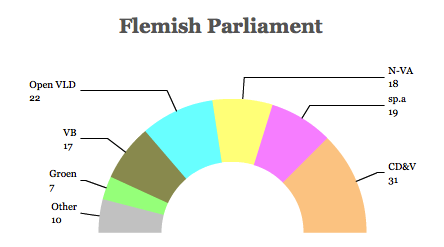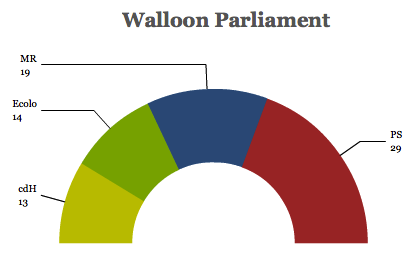You’d be forgiven if you forgot that, on the same day as Europeans elect the European Parliament and Ukrainians elect a president, Belgium, too, will elect a new national government — and the northern, Dutch/Flemish-speaking Flanders and the southern, French-speaking Wallonia will both elect regional governments. ![]()
It’s the first parliamentary elections in Belgium since June 2010, which were so fractured and inconclusive that it took 541 days for a coalition government to form under the premiership of Walloon socialist Elio di Rupo (pictured above).
Polls this time around show that most Belgian parties will win roughly the same amount of support in 2014 as they did in 2010, which means that Belgium could be in for another wrenching year or more of coalition negotiations. Due to the linguistic and regional differences between Flemish and Walloon voters, two completely different sets of parties compete for Flemish and Walloon votes, respectively.
Even though the Scottish and Catalan independence votes later this autumn have attracted wider attention, there’s an equally strong chance that Belgium could cease to exist in everything but name if two consecutive elections fail to give the country a stable government.
Initially, in the decades after Belgian independence in 1830, the French-speaking Walloon region was traditionally wealthier. After World War II, however, Flanders increasingly dominated Belgian economic output, and Flemish leaders have correspondingly demanded greater policymaking autonomy from Belgium’s national government.
Beginning in the 1960, chiefly at Flemish initiative, increasing amount of power have already been devolved to regional government, where regional parliaments were formed in 1981 and their members have been directly elected since 1995.
With a national population of around 10.75 million, there are just over 6 million people in Flanders and just over 4 million people in Wallonia. Within Belgium, each of Wallonia, Flanders and Brussels now have a regional parliament, and there’s now a parliament for German-speaking Belgians. Moreover, the country is split into three regions for administration purposes: Wallonia, Flanders and Brussels, the country’s capital, which is located just within Flanders but which has a French-speaking majority.
Though just a small minority of Flemish voters want independence, many leading Flemish parties have successfully pushed for greater regional autonomy. Another inconclusive election could lead to reforms that give the two regions almost complete autonomy in a confederal arrangement that would leave a shell of a national government that administers foreign policy and controls little domestic policy.
But who will emerge in the regional governments after Sunday’s elections? After all, even under the current state of Belgian federalism, the Flemish and Walloon governments matter just as much, if not more, than the national government.
In Flanders, the contest is largely between the Christen-Democratisch en Vlaams (CD&V, Christian Democratic and Flemish), the traditional Flemish center-right party, which favors greater autonomy for Flanders as a way of avoiding Belgian separation, and the Nieuw-Vlaamse Alliantie (N-VA, New Flemish Alliance), a pro-secession party that hopes to win increasing autonomy for Flanders for the express purpose of hastening independence.
Both parties are members of the current regional governing coalition, which is headed by Kris Peeters (pictured above), the leader of the CD&V, and which generally agrees with the N-VA on most fiscal matters and even on most matters of political reform, even if their long-term goals for Flanders and Belgium vary.
Going into the elections, the CD&V holds the largest share of seats in the 124-member Flemish parliament.
Since the last regional elections in 2009, the N-VA has surged — its success in the 2010 national vote is one of the main reasons that it took so long to form a Belgian government. Its leader, Bart de Wever, was elected mayor of Antwerp in 2012, and the N-VA is favored to win both the regional and national elections in 2014, even though most Flemish voters disagree with its stand in favor of independence.
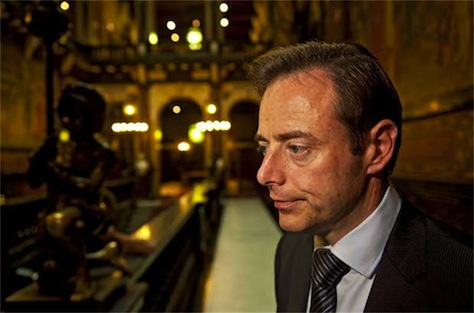
De Wever (pictured above) has downplayed Flemish independence, however, in favor of a traditional campaign on economic issues. Although the N-VA has been part of the government for the past five years, De Wever and the N-VA are running on a ‘change’ platform of lower taxes and lower government spending, including a two-year limit on unemployment benefits. Its campaign seems to be working.
The death last week of Jean-Luc Dehaene, Belgium’s national prime minister between 1992 and 1999, who is credited as one of the founding fathers of the eurozone, could maximize CD&V support as voters remember one of the leading CD&V officials of the last half-century.
The latest De Standaard poll gives the N-VA around 31% of the vote for the Flemish regional election, with just 20% for the CD&V.
Peeters’s position as minister-president lies in the balance. Even if the N-VA wins a decisive victory against the CD&V, no party is expected to win an outright majority. So Peeters could still win a second term as minister-president if coalition partners refuse to serve in a government headed by the N-VA.
The third member of the current government, the Socialistische Partij Anders (sp.a, Socialist Party Different) is the chief Flemish center-left party, and it is currently winning around 15% of the vote.
The Open Vlaamse Liberalen en Democraten (Open VLD, Open Flemish Liberals and Democrats), founded as a Flemish free-market liberal party under former prime minister Guy Verhofstadt, who led Belgium’s national government between 1999 and 2008, has steadily moved leftward in the past six years. It wins around 14% of the vote.
Rounding out the Flemish political scene is Groen (Green), a standard European left-green party, which wins around 9%, and Vlaams Belang (VB, Flemish Interest), a far-right Flemish nationalist party that seeks not only Flemish independence, but strict immigration controls. VB is polling at around 8%, a sharp drop from the 15% it won in the 2009 regional elections.
If the contest in Flanders is generally between two center-right parties, reflecting that region’s general tilt rightward, there’s not really much of a contest at all in the Walloon region, where the governing Parti Socialiste (PS, Socialist Party) has a steady lead in every poll conducted in advance of the elections, reflecting Wallonia’s leftward tilt.
The Socialists currently lead a government along with Ecolo, the Walloon green party and with the centrist, Christian democratic Centre démocrate humaniste (cdH, the Humanist Democratic Centre) in the 75-member regional parliament:
A poll from last week in the French La Libre shows the Socialists winning around 29%, down from previous elections, but enough to form another center-left government under minister-president Rudy Demotte. The center-right, liberal Mouvement Réformateur (MR, Reform Movement) wins around 22%, the cdH around 12% and Ecolo around 9%.
Ironically, Didier Reynders, the leader of the Reform Movement, the chief opposition leader at the regional level, has also served as Di Rupo’s foreign minister at the federal level since the current government took shape in late 2011.
Moreover, Reynders (pictured above) served as finance minister from 1999 to 2011, throughout the entire Verhofstadt government and the ensuing governments of Herman Van Rompuy and Yves Leterme, both from the Flemish CD&V. Since 2004, he has also served as Belgium’s deputy prime minister, making him a constant in each of the Verhofstadt, Van Rompuy, Leterme and now Di Rupo governments.
If his Reform Movement maximizes its turnout, and far-left parties and disillusioned supporters minimize the Socialist vote, there’s a chance Reynders could emerge with as the leading French language bloc regionally and/or nationally — in either event, it would put Reynders in the driver’s seat, so to speak, of any regional or national government.
All 89 members of the Brussels-Capital Region parliament will be elected this weekend, too — 72 members come from a list of French-language parties, while 17 members come from the Dutch-language list. Notably, because Brussels lies within Flanders, voters who choose from the Dutch-language list of parties can also participate in the Flemish regional elections.
Given the predominance of the French-language parties, the race is shaping up as a tighter contest between the Socialists and the Reform Movement — given the relatively more conservative Flemish electorate, that makes intuitive sense.
Federal elections
Leaving the regional picture behind, what does all of this mean for federal elections?
As part of the deal that resulted in the government that Di Rupo now leads, the ‘Butterfly Agreement’ (Vlinderakkoord/L’accord papillon), named in reference to the bow ties that Di Rupo always wears, members of the upper house of the Belgian national parliament, the Senate (Senaat/Sénat), are no longer elected directly in national elections.
That means that Belgians will be electing only the 150 members of the lower house, the Chamber of Representatives (Kamer van Volksvertegenwoordigers/Chambre des Représentants) in the May 25 elections. Among the 150 seats, 88 derive from Dutch-language constituencies in Flanders (including 1-2 seats based in Brussels) and 62 derive from French-language constituencies, mostly in Wallonia (including 13-14 seats in Brussels).
As in 2010, polls show that the mildly separatist, center-right N-VA will win the largest share of the vote, on the basis of its strength in Flanders.
As in 2010, however, that means that Belgium will face difficult negotiations — the current government that came to power only in December 2011 is a united front of Flemish and Walloon parties on both the left and the right, united by the desire to keep the N-VA out of government.
The Di Rupo government includes three of the four major French-speaking parties: the Socialists, the Reform Movement and the cDH. It also includes three of the Flemish federalist center-right and center-left parties, the CD&V, Open VLD, and the Socialists:
Di Rupo, Belgium’s first openly gay prime minister, and its first native French-speaking prime minister since 1979, has worked to maintain the country’s financial credibility over the past 2.5 years, often implementing unpopular measures more typically associated with a center-right government, including €22 billion in budget savings, enacted at a time of near-zero economic growth — the economy actually contracted by 0.2 in his first full year in office. In that regard, Di Rupo’s greatest accomplishment might be in holding the six-party coalition together through the end of the parliamentary term.
Following a 541-day stint without a government, Belgium increasingly found itself subject to speculation that it could follow Greece, Spain, Portugal and Italy, with debt yields rising to unsustainable levels, especially in light of a public debt load of around 100% of GDP. Though successive governments have reduced Belgian public debt from a high of around 140% in the early 1990s, investors will be watching the aftermath of the Belgian national elections closely. Though Belgium pulled though its government formation crisis without too much damage in 2011 and 2012, there’s no guarantee that global markets will have the same level of patience if it takes until the end of 2015 to form the next Belgian government.
Two options seem likely.
The easiest might be to continue Di Rupo’s broad, cross-language, cross-ideology government. This option depends on the Socialists winning a clear plurality bloc of French seats. It also depends of Reynders, a longtime federalist who has preferred to prop up a Socialist-led federal government rather than allow the N-VA to join the federal government.
The other, more tantalizing option, is a ‘Flemish front’ government that could bring together the major center-left and center-right parties, including the N-VA, especially if the far-right Vlaams Belang has serious losses. This option essentially depends on Peeters and other leaders in the CD&V, which as the second-largest Flemish bloc, is almost certain to be the key partner in any major governing coalition.

